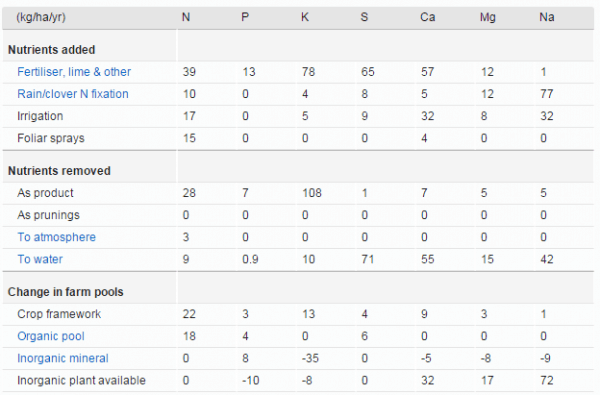Mike Nelson and Greg Dryden, Fruition Horticulture, Nelson (First published in The Orchardist magazine)
Like many areas in our modern society, professional advisors are now more and more being held accountable and are expected to prove competency and meet minimum professional standards.
In this article, we’ll explain about the recently developed scheme to certify nutrient advisors and provide some examples of the impact of nutrient practices.
The Nutrient Management Advisor Certification Programme (NMACP) was set up in 2012 to develop (and uphold) a transparent set of industry standards for nutrient management advisors to meet, so that they provide consistent advice to a high standard. A group of Primary industry sectors, including Horticulture NZ has advisory input into the scheme.
To become certified, advisors have to demonstrate they have appropriate qualifications or equivalent field experience, with a suitable training record. Generally advisors are required to complete the Intermediate and Advanced courses in Sustainable Nutrient Management in NZ Agriculture at Massey University. Both courses include horticulture. Advisors are also required to achieve a high pass grade on a rigorous competency assessment. These courses ensure that advisors understand nutrient cycles, sustainable use of agri-nutrients and environmental considerations. Advisors are then qualified to prepare nutrient budgets and nutrient management plans. To stay certified, advisors are required to complete at least 15 hours of professional development per year, with mandatory training components.
Certified advisors are also qualified to use the nutrient budgeting software tool OVERSEER®. This application has been developed to help farmers and growers to make informed strategic management decisions about their nutrient use, improve performance and reduce losses to the environment. Given a soil and climate type, OVERSEER® models a seasonal nutrient usage by crop development stage, accounting for all nutrient inputs and losses. Rates, products and application timing can be adjusted and the resulting impact on crop performance and environmental losses can be assessed.
OVERSEER® was primarily developed to meet the needs of the dairy and pastoral sector, however nutrient budgets can be conducted on apples, kiwifruit, peaches, avocados and vegetable crops and development is ongoing.
The spotlight has been on dairying due to greater losses of nutrients into the environment from this type of farming operation. Most people think that fertiliser use is the main culprit but this isn’t so. The animal is by far the bigger contributor by depositing a massive dose of nitrogen in concentrated urine spots that the soil cannot hold or use, and consequently is leached down through the soil profile. This particularly so at higher stocking rates. In fruit production, nutrients are applied in a much more uniform application rate and tend to be applied outside the wetter winter months, when there is less leaching and higher plant utilisation.
In a recent report prepared by Landcare Research, annual nitrogen leaching losses on a Waimea soil type (averaged over 40 years) was found to be about 6.5kg/ha for apples and about 60kg/ha for dairy production (Fenemor, A. et al).
Table 1 shows a nutrient budget prepared in OVERSEER® for a 70T apple crop on one hectare. It shows total nutrients coming into the block both as applied by the grower and passively through rainfall and irrigation. In this case nutrients removed to water is 9kg/ha per year for nitrogen (N) and 0.9 kg for phosphorus (P). The bottom line in the table shows the change in the nutrient soil pool for the season. The nutrient ‘bank’ if you like. P is showing as -10 which indicates that the phosphate levels are likely decreasing over time by about 1 Olsen-P unit per year. Potassium (K) also appears to be decreasing although it would take a shift of 125kg to reduce the MAF Quick Test by one unit, so effectively there is little change. This information should be compared with soil test results over time to confirm trends.
For this same scenario OVERSEER® modeled a nitrogen concentration in drainage water to below the rooting zone of 1.1 ppm. The maximum recommended level for drinking water is 11.3 ppm.
Table 1: Nutrient budget report from OVERSEER® for an apple crop at 70T/ha

Regional councils have supported the NMAC programme and it is likely, over time, they will require that certified advisers should be used to produce compliant nutrient management plans.
There are now 100 certified advisors nationally and they are listed by region at the website: www.nmacertification.org.nz/Site/Nutrient_Management/Certified_Advisers/default.aspx
Reference:
Fenemor, A., Green, A., Dryden, G., Samarasinghe, O., Newsome, P., Price, R., Betts, H., and Lilburne, L. (2015). Crop Production, Profit and Nutrient Losses in relation to Irrigation Water Allocation and Reliability – Waimea Plains, Tasman District. Landcare Research, June 2015